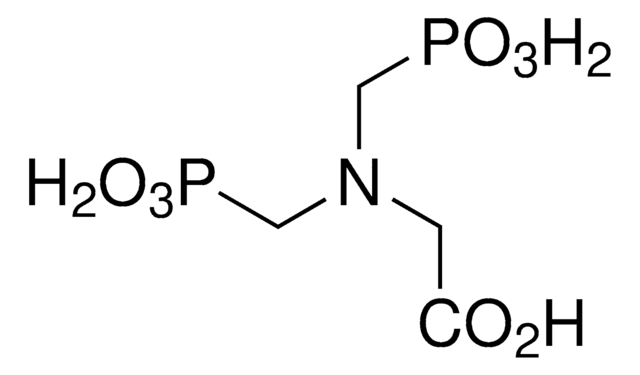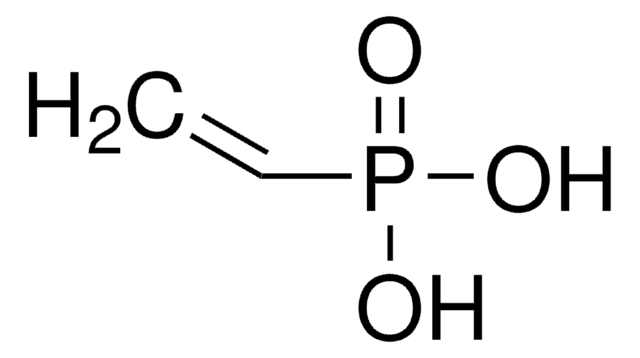If this product has an expiration or retest date, it will be shown on the Certificate of Analysis (COA, CofA). If there is no retest or expiration date listed on the product's COA, we do not have suitable stability data to determine a shelf life. For these products, the only date on the COA will be the release date; a retest, expiration, or use-by-date will not be displayed.
For all products, we recommend handling per defined conditions as printed in our product literature and website product descriptions. We recommend that products should be routinely inspected by customers to ensure they perform as expected.
For products without retest or expiration dates, our standard warranty of 1 year from the date of shipment is applicable.
For more information, please refer to the Product Dating Information document: https://www.sigmaaldrich.com/deepweb/assets/sigmaaldrich/marketing/global/documents/449/386/product-dating-information-mk.pdf
36818
Diethylenetriaminepentakis(methylphosphonic acid) solution
technical, ~50% (T)
Sinônimo(s):
Diethylenetriamine-N,N,N′,N′′,N′′-penta(methylenephosphonic acid), Diethylenetriamine-N,N,N′,N′′,N′′-pentakis(methylenephosphonic acid), Diethylenetriaminepenta(methylenephosphonic acid), Diethylenetriaminopenta(methylenephosphonic acid), Ethylenetriaminepenta(methylenephosphonic acid), P,P′,P′′,P′′′-[[(Phosphonomethyl)imino]bis[2,1-ethanediylnitrilobis(methylene)]]tetrakis[phosphonic acid]
Selecione um tamanho
Selecione um tamanho
About This Item
Produtos recomendados
grau
technical
Formulário
liquid
composição
HCl, 15%
H2O, ~35%
concentração
~50% (T)
grupo funcional
amine
cadeia de caracteres SMILES
OP(O)(=O)CN(CCN(CP(O)(O)=O)CP(O)(O)=O)CCN(CP(O)(O)=O)CP(O)(O)=O
InChI
1S/C9H28N3O15P5/c13-28(14,15)5-10(1-3-11(6-29(16,17)18)7-30(19,20)21)2-4-12(8-31(22,23)24)9-32(25,26)27/h1-9H2,(H2,13,14,15)(H2,16,17,18)(H2,19,20,21)(H2,22,23,24)(H2,25,26,27)
chave InChI
DUYCTCQXNHFCSJ-UHFFFAOYSA-N
Categorias relacionadas
Descrição geral
Aplicação
Outras notas
Palavra indicadora
Danger
Frases de perigo
Declarações de precaução
Classificações de perigo
Eye Dam. 1 - Met. Corr. 1 - Skin Irrit. 2 - STOT SE 3
Órgãos-alvo
Respiratory system
Código de classe de armazenamento
8A - Combustible corrosive hazardous materials
Classe de risco de água (WGK)
WGK 1
Ponto de fulgor (°F)
Not applicable
Ponto de fulgor (°C)
Not applicable
Equipamento de proteção individual
Faceshields, Gloves, Goggles, type ABEK (EN14387) respirator filter
Escolha uma das versões mais recentes:
Já possui este produto?
Encontre a documentação dos produtos que você adquiriu recentemente na biblioteca de documentos.
Os clientes também visualizaram
-
How can I determine the shelf life / expiration / retest date of this product?
1 answer-
Helpful?
-
-
How is shipping temperature determined? And how is it related to the product storage temperature?
1 answer-
Products may be shipped at a different temperature than the recommended long-term storage temperature. If the product quality is sensitive to short-term exposure to conditions other than the recommended long-term storage, it will be shipped on wet or dry-ice. If the product quality is NOT affected by short-term exposure to conditions other than the recommended long-term storage, it will be shipped at ambient temperature. As shipping routes are configured for minimum transit times, shipping at ambient temperature helps control shipping costs for our customers. For more information, please refer to the Storage and Transport Conditions document: https://www.sigmaaldrich.com/deepweb/assets/sigmaaldrich/marketing/global/documents/316/622/storage-transport-conditions-mk.pdf
Helpful?
-
-
What is the density of this solution?
1 answer-
The density of this product is not tested. The material Safety Datasheet reports a density of 1.420 g/cm3, based on literature.
Helpful?
-
Active Filters
Nossa equipe de cientistas tem experiência em todas as áreas de pesquisa, incluindo Life Sciences, ciência de materiais, síntese química, cromatografia, química analítica e muitas outras.
Entre em contato com a assistência técnica










